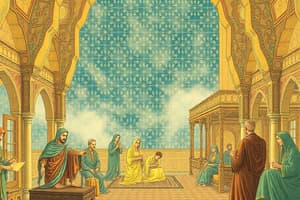Podcast
Questions and Answers
What is fundamental to the covenant idea as discussed in the text?
What is fundamental to the covenant idea as discussed in the text?
- Tracing genealogy back to Adam
- Awaiting the Messiah
- Being delivered from oppressive rule
- Obeying God and upholding the laws (correct)
According to the 'Deuteronomic' view of history, what happened when Hebrews strayed from their covenant responsibilities?
According to the 'Deuteronomic' view of history, what happened when Hebrews strayed from their covenant responsibilities?
- They awaited the Messiah
- They were delivered from oppression
- God punished them (correct)
- They were rewarded with success
What is the role of a prophet as discussed in the text?
What is the role of a prophet as discussed in the text?
- Awaiting the Messiah
- Tracing genealogy back to Adam
- Delivering messages from God to humans (correct)
- Being rewarded with success
Which Gospel traced Jesus' genealogy all the way back to Adam?
Which Gospel traced Jesus' genealogy all the way back to Adam?
In Christianity, who is considered the 'New Adam'?
In Christianity, who is considered the 'New Adam'?
Why did Luke trace Jesus' genealogy all the way back to Adam in his Gospel?
Why did Luke trace Jesus' genealogy all the way back to Adam in his Gospel?
'Awaiting Mesiah' - what does this term refer to in the text?
'Awaiting Mesiah' - what does this term refer to in the text?
What is the significance of Jesus according to John's Gospel?
What is the significance of Jesus according to John's Gospel?
What is the main theme introduced in Matthew's Gospel by tracing Jesus' genealogy back to Abraham?
What is the main theme introduced in Matthew's Gospel by tracing Jesus' genealogy back to Abraham?
What distinguishes Mark's Gospel from Luke’s Gospel in terms of tracing Jesus’ ancestry?
What distinguishes Mark's Gospel from Luke’s Gospel in terms of tracing Jesus’ ancestry?
Flashcards are hidden until you start studying
Study Notes
Social Structure and Economy
- Arab tribes were pastoralist in nature, with people divided into independent tribes that formed alliances as needed, but these arrangements were fragile and subject to rapid dissolution.
- Genealogy was crucial to Arabs, as preserving family, clan, and tribal purity and honor was paramount.
- The main means of livelihood for Arab pastoralists were raising camels and sheep, hunting, serving as bodyguards or escorts to caravans, or being hired as mercenaries.
Hejaz Pre-Islamic Religion
- Pre-Islamic Arabs in the Hejaz region revered stones, wells, trees, and sacred precincts connected to their tribe's origins.
- They recognized many deities, with the Ka'ba in Mecca containing 360 deities on the eve of Islam.
- People made sacrifices at various shrines, each community or town having its own patron deity, with both male and female divinities.
- Over time, nobles and common people identified with Osiris, leading to a democratization of the Osirean afterlife.
- This afterlife was dependent on living a good life on earth, a concept that would influence Abrahamic religions.
Ancient Egypt
- Ancient Egyptian ideas of justice, final judgment, and punishment or reward have been incorporated into Abrahamic religions, including Islam.
- The Egyptian concept of Ma'at (justice) involved a weighing of deeds on scales, with a focus on living a good life on earth to achieve a good afterlife.
- Christianity, Judaism, and Islam differ from ancient Egyptian beliefs in their concept of resurrection and afterlife.
Prophets and the Covenant
- Prophets transmit messages from God about the divine world to humans.
- The covenant idea, established with Abraham and renewed at Sinai, is central to Abrahamic religions, linking historic processes to divine significance.
- The Deuteronomic view of history states that when people obey God and uphold laws, they are rewarded, but disobedience leads to punishment.
Christianity
- Jesus of Nazareth is central to Christianity, with the Gospels tracing his ancestry and message.
- The Gospels of Mark, Matthew, Luke, and John provide different accounts of Jesus' life, with a focus on his redemption of humanity.
Studying That Suits You
Use AI to generate personalized quizzes and flashcards to suit your learning preferences.




